Description
- [Wide Application] 800Wh daily output depends on the 4 hours sunlight availability; suited for applications that require a smaller footprint, making it a favorite for those with RVs, campers, caravan, boat, Green house and more
- [Excellent Performance] 22% High solar cell efficiency; Corrosion-resistant aluminum frame for outdoor use, allowing the panels to last for decades as well as withstand high winds (2400Pa) and snow loads (5400Pa)
- [Multiple Protection] The Renogy Adventurer-Li 30A PWM charge controller is designed for aesthetically clean flush mounting on RV or camper walls; Protection against: overcharging, overload, short-circuit, and reverse polarity
- [Easy Installation] Pre-drilled holes and Plug&Play cables on the back allow for fast mounting, and it supports lithium batteries, lead-acid batteries, gel batteries; 3 pairs of Y branch connectors are newly added to meet your parallel requirements
- [Warranty] 5 year warranty and 24/7 technical support team.
- Protection Degree: IP67, mated ; Temperature: -40°F to +194°F
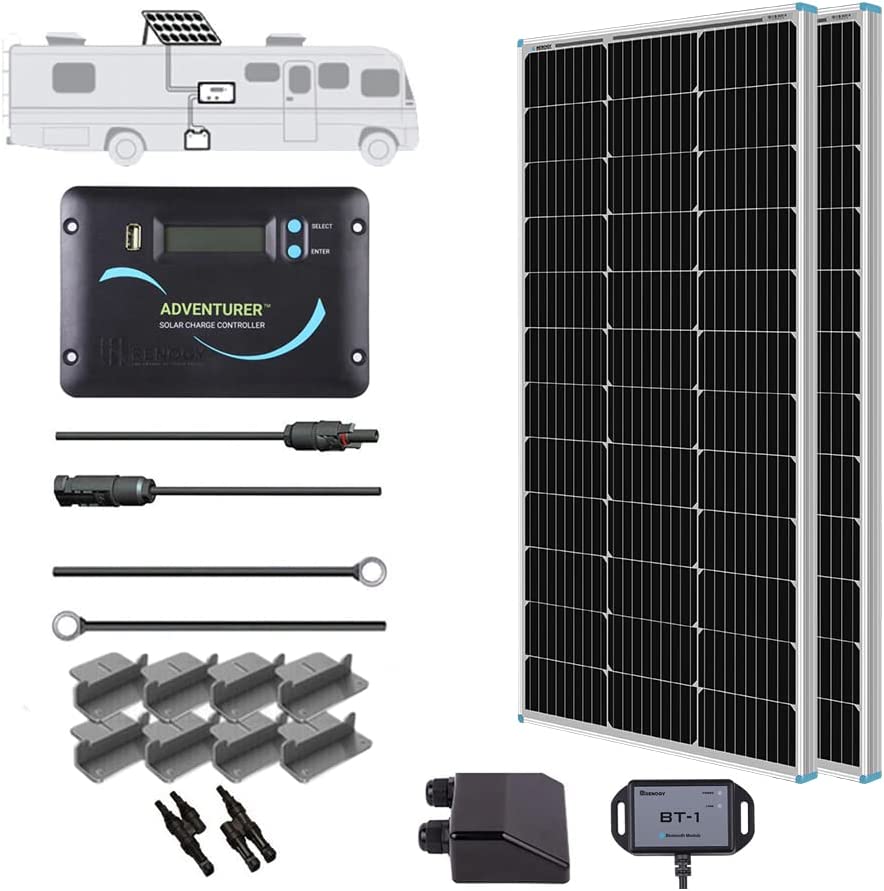
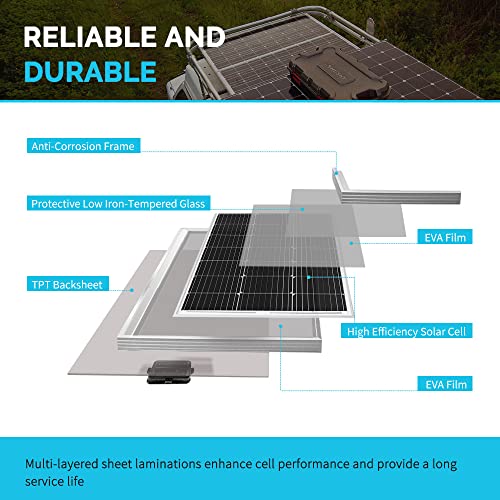
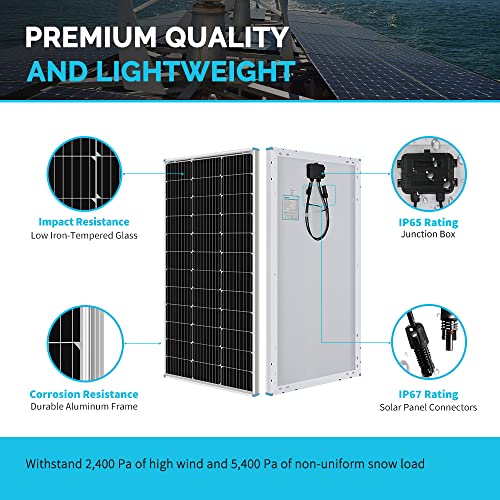
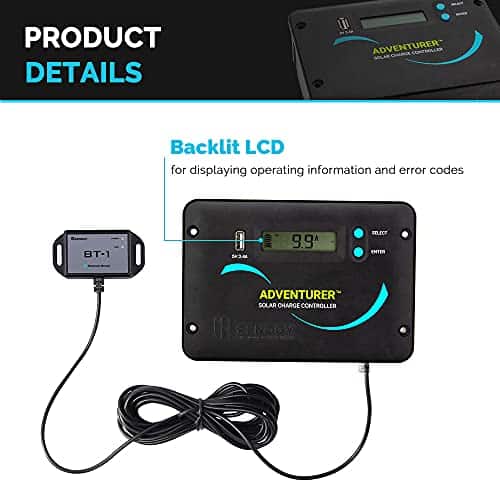
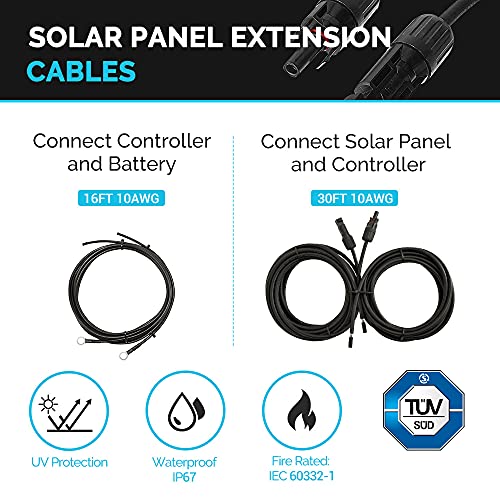
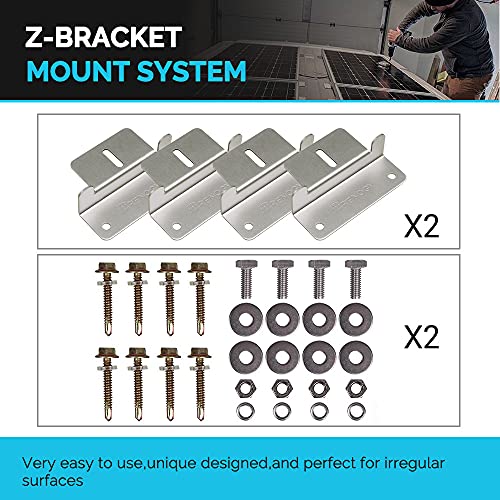


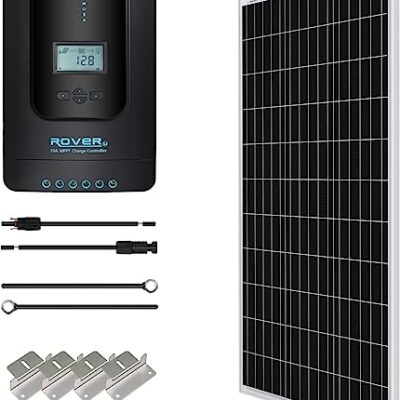
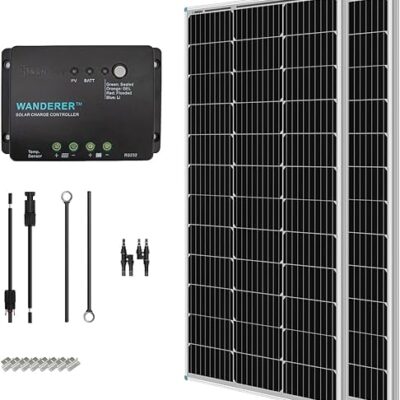
Joe From NC –
I wish I would’ve went with his system from the beginning. I purchased the 200 watt system. After getting everything figured out and installed this system has been running on its own in my driveway in a test mode now for over a week. I’ve been running a medium sized portable 55qt. refrigerator set at 30 degrees on 12v continually, and an exhaust fan (during the day only) plugged into the auxiliary outlets that I have rewired to run on the auxiliary batteries. It is able to keep up with the fan running on high, and the refrigerator in direct sunlight throughout the day. The app showed 100% battery level during peak sunlight. This is fantastic for me because I want to be off the grid while camping. I would highly recommend this system for an entry level RV addition. Don’t waste your time with harbor freight solar panels or any of that junk they sell. It was a big waste of money for me. That junk left me with a dead battery on my van with my previous setup. You get what you pay for came to mind. So I went all out to build a independent system to power all my needs while camping. All the parts you need to swap your E series Ford van you can get on Amazon. I installed a switch to connect the auxiliary batteries to the vans main battery to recharge in a pinch, this was a great addition as a back up as most RVs have this in their system anyway. The battery boxes are for the diesel version of E350 found on Ebay. The batteries you can get for almost half price at Costco. I supplied some photos of what I did. It works great bottom line! I got everything in the box from Renogy as promised, not as some have complained about in their reviews. Plenty of cable is supplied to do just about everything you need. The Bluetooth app is a welcome edition. Great job Renogy!
Sourdo –
This kit is well made. All the hardware is either aluminum or stainless steel (no plated screws or fasteners). The cables are 10 gauge tinned copper and have thick insulation that looks likely to last a long time.
My only issue is with the voltage controller design. If you surface mount the unit you cannot hide the wires. The wires have to come from below to fit into the terminals. Also, if you want to disconnect a wire you have to take the unit off the wall to access the screws on the terminals. Not the best design choice for terminals.
If you recess mount the controller this will not be an issue.
It would have been nice to have some weather resistant zip ties included in the kit. Get stainless cable clamps with rubber protectors and some UV and weather resistant zip ties for your install – it will help.
Sourdo –
Things were going well. Very easy to install, and the setup was simple. I think I got a defective one though. I brought it on the highway twice, the second time, no good. As you can see from the pictures, the solar panel was completely ripped off and separated. The bolds are still intact, just no solar polar. I was very fortunate that it blew off to the right, and over a cliff, vice left or behind and into someone’s vehicle. Not sure how it didn’t hold, I believe it is machined aluminum. anyway, Phew!
Michael Chlopik –
Def recommend. Everything is well made, the quality shows instantly. Everything works as described, easy install, out performs others I’ve bought. Keep on 👊👊👊
Steve Bogdon –
This setup will provide enough power to run every thing in my truck camper and keep my single 100 amp hour batter at or near full charge.
I’ll be adding a inverter and automatic transfer switch. Or maybe save for renogys combo inverter charger.
Joe From NC –
Be sure you understand that PWM controllers are only 70-80% efficient. The most output I have ever seen was 141watts. This is with panels on an cargo trailer roof, trailer tilted 10 degrees (30 degrees is ideal), and very sunny days with zero clouds or shading. Normally seeing 120 watts.
Nice panels and good amount of wiring. The PWM solar charge controller works fine (I had ZERO issues with the Bluetooth/app) but it is not efficient. Lesson learned on my part – I did not realize how inefficient they are. After chatting with Renogy (I had no issues with getting tech support either – waited less than 1 minute) they explained the controller was 70-80% efficient so 140watts of output from the 2 panels is normal.
Again – bluetooth app “DC Home” works excellent on my S20. And the two times I contacted tech support – there was not any wait or issues (once in chat and once via email).
I bought it on a lighting deal so no regrets – even if I throw out the controller there is no way I could have bought all the other parts separate for less.
Amazon Customer –
Je suis en plein soleil et m’indique 46 watts de charge sur 200 ????
Steve –
Just finished installing this kit. It was an easy install after downloading and reading the PDF instructions. It’s fairly intuitive anyway. Plenty of wire length for the install, although I installed this kit on a slide in truck camper. After hooking everything up on a sunny hot day (3,800 feet elevation in high desert) the charge controller was reading “PV array voltage 16.1V, charging current 7.4A”. I used 2 flooded acid RV battery’s hooked up in parallel for a 12V system. I haven’t stressed the system yet and will update after some use. A couple recommendations: (1) Make sure to hook up the battery to the charge controller FIRST !! (2) Don’t forget to install 30 amp fuses, not included. (3) I recommend installing 2 heavy duty on/off switches. One to disconnect the battery, and one to disconnect the solar panels (through the positive + wire).
kevin s –
Love the kit, everything is as described.
NMG –
hubby installed this and it works great
Steve –
I bought the 200 watt RV “Kit”. I say kit lightly, it was a bit short.
The package arrived in great shape, in a well made cardboard box. This kit contains only the basic items for an install. The panels seemed very well built and strong.
I’ll get the bad out of the way first.
First there are no fuses, and I had to order these after the fact. I would of gladly paid more for a “kit” that had everything I needed. This is an electrical setup and circuit protection is needed. It would of been just to easy to have the inline fuse onboard in the first place, and IMHO, should of been.
Then I tried Renogy’s site to order one, but they want a ridiculous amount of money to ship UPS, it was like $57 to ship an item that would fit in an envelope and mailed USPS for ten bucks. It’s a $17 item. So that option was out, I ordered a fuse from Amazon, which can take up to 4 weeks.
Second, the through the roof housing gland for the cables, has no flange. There is no way to screw it down to the roof. Even pictures on Renogy’s site shows the housing, with a flange. As does other solar suppliers. Really quite dumb. I threw mine away as it was useless. What were they thinking?
Third, the blue tooth app is broken. A great idea, but it freezes up constantly to the point it is useless. I hope Renogy is working hard on this issue.
The kit does come with plenty of wire. But it is of some unknown white metal, not copper. Not aluminium, it won’t melt. I soldered the wire ends that go into the controller lugs for superior connections. And any ring connectors I cut off, and replaced with heavier better ring connectors, and soldered those on, and used heat shrink. Soldered connections are the way to go. Not the best wire IMHO, but adequate.
My RV is older, and has no plywood on the roof, just heavy metal. I had to buy two 10 foot pieces of Super strut cut down, and 1/4 in bolt receivers for the supplied Z brackets. And with that I was able to attach to the roof joices 16 inch on center, with 5/16 in x 1 1/2 inch lag screws. IT is very securely mounted. I placed pieces of plywood around to walk on.
Nothing about these panels lines up to standard American carpentry measures. Super strut has holes, that line up to 16 inch on center for easy mounting. I mounted the panels on the roof edge to make it easy to get to with a small ladder for cleaning. The panels can be removed without leaving holes in the roof.
The first thing I did with the wiring was to use red electrical tape, and clearly mark each end of the positive wires. Even on the panels, mark them, once mounted you can’t see the + or -. That will keep you from mixing things up. Then I made my wire runs.
The wall I mounted the controller on has a vent pipe, and that was my access point for the wires. The controller functions well enough. I was able to change the battery type to sealed (SEL) for my AGM 70 AH (x2) deep cycle 12 volt batteries. It has a log function to record how much power it makes. The phone app has much more in graphs and usage data, but unfortunately it don’t work very well.
I included an cutoff switch for the solar panels. IF the batteries are disconnected while the panels are connected, the controller will fry. This is clearly stated in the brief instructions. This is much easier then crawling up on the roof and pulling apart the connectors.
Once the batteries were reconnected, I turned on the panels, and charging began. So far it is working very well. I gave the batteries a work out yesterday, ran the inverter with a shop vac, turned on the vent fan, and I was getting 135 watts/9.3 amps of solar power in bright sunlight. I was impressed. The batteries were charged up and back in “float” mode quickly.
So far so good, we boondock often, and after a couple of nights, I need to hook up the truck and recharge. Those days are gone!
Edit July 20, 2020
I became so dissatisfied with the Renogy controller, I spent $120 and bought a better SCC, the Victron 75/15 MPPT SmartSolar. It works flawlessly in all regards. Especially on cloudy days, this became an issue. I have a review on that unit here. https://www.amazon.com/gp/product/B075NQQRPD/ref=ppx_yo_dt_b_asin_title_o04_s00?ie=UTF8&psc=1
In essence, in the Renogy “kit” I ordered, only the solar panels and wire were worth keeping. My advice, buy the panels, get some wire, but pass on the Renogy controller, bluetooth dongle (a total waste of $45, and I do mean a waste of money), and most certainly the threw the roof glan.
For all that I am reducing the stars to two.
Iron Clad –
Installed 2 days ago. First advise…. READ EVERYTHING FIRST! including the full manual available from Renogy website as this does not come with the kit. I did notice this in a few other reviews as well.
Pro – Kit was fairly easy to install once directions are full understood.
Pro – Kit comes with more than enough wire for the install on my Jayco 212QB
Pro – It was unclear in the Amazon description weather or not the BlueTooth module was included as it sort of made it look like an add-on option. Good news this kit does include this module and it works very well. I would say this module is a MUST HAVE.
Con – My kit was already opened by another customer. One solar panel was dirty and one bag of wiring was opened and repackaged. I paid for a brand new kit not a kit that was recycled.
Con – As mentioned READ EVERYTHING. It is mentioned 4 times in the install manual that you MUST have a battery connected to the charge controller BEFORE attaching the leads from the solar panels. BUT there is no way other than climbing onto the roof and manually disconnecting the solar panels at the connectors to disconnect solar supply when changing a battery or disconnecting a battery for long term storage. If a user MUST connect a battery before solar panels are hooked up why does the charge controller not have an on/off switch or have a inline switch a user can mount themselves. I got around this by routing the solar panel leads through the exterior refrigerator access panel and mounting a switchable circuit breaker there. I have a tag on my battery leads reminding me or perhaps a repair tech of the need to turn off solar system before disconnecting battery.
Con – no fasteners or even suggestions to secure wiring to roof. I ended up wrapping my wiring in a flexible conduit and fastening to A/C housing before sneaking into the refrigerator roof vent.
Hope this helps. All of this known I would buy again and might still add 2 additional panels if ever needed.
Steve